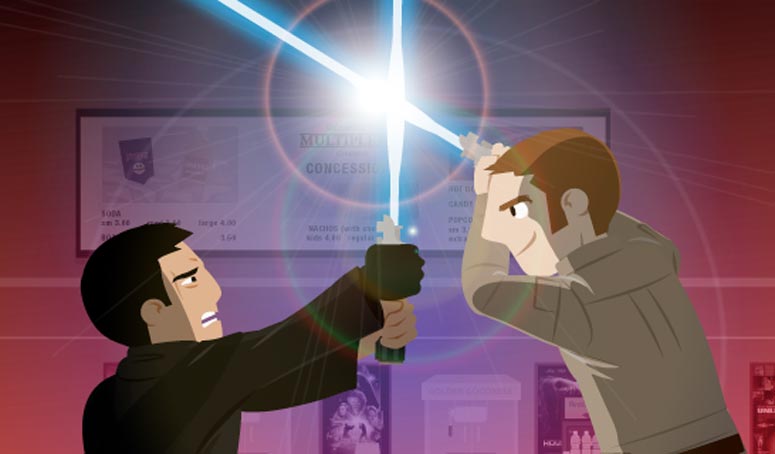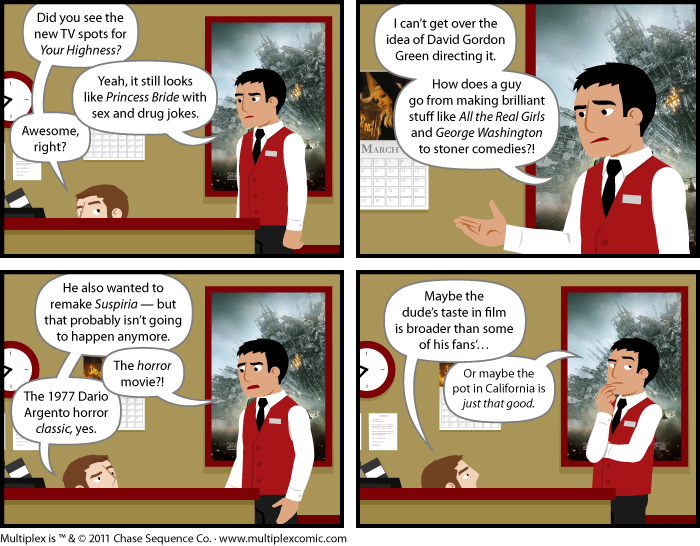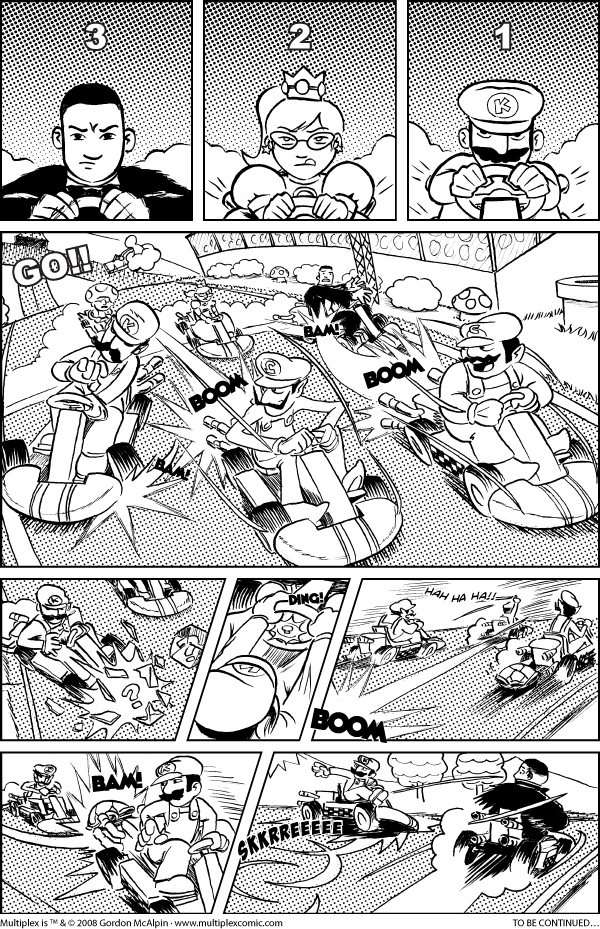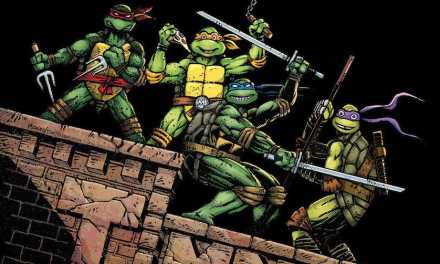
Gordon McAlpin’s Multiplex Comic Strip Ends After 12 Years

There is a palpable sense of loss in the ending of a good story. It’s the heavy sensation in your gut from the realization that what you are viewing/reading/or experiencing comprises the last moments with that story as a living entity. It’s the understanding that characters you have grown with for years are near the end of their evolution. There will be no further continuation. This is the end. We all have to move on.
Audiences famously experienced this with “Logan” ending Hugh Jackman’s run as Wolverine in theaters this past month. But while that movie received a proper amount of acclaim, there’s another film related project quietly nearing its conclusion. Gordon McAlpin’s Webcomic “Multiplex” will end a successful 12 year run with the publication of its final strip on April 10th.
Gordon McAlpin began the strip in July of 2005. The first entry is relatively simple. One of the leads, Kurt Bollinger, sells a ticket to a customer who makes the type of joke that all folks who have worked as some sort of cashier have heard before.

McAlpin spent the first year or so of the series finding his artistic footing. He utilized a twice a week release format to establish a diverse cast of characters. His two leads, Jason Atwood and the aforementioned Kurt Bollinger, are movie theater employees in their early twenties. Their adventures are easily relatable. They make wisecracks and deal with the gentle insanity that is customer service.

Had “Multiplex” continued like this in perpetuity it would have been fine. It could have carved out a Penny-Arcade-esque niche of topical satire and humor. But, something happened about a year into the strip (starting around entry #67), McAlpin began using the world he had established to tell a continuous long-form story. This was when the strip really took off.
McAlpin gently shifted the focal point of the story to the Jason Atwood character. Atwood is relatable and real. He’s funny and intelligent, without having all of the answers. We follow the triumphs and failures in his personal life while he struggles to find his place as part of the lost generation that came into adulthood in the mid aughts.
This is not to say that the proceedings become overly melodramatic. There is just the right amount of comedy, drama, film commentary and most of all…fun. McAlpin uses his talents as a writer to create a unique voice for each character in the diverse ensemble. Jason Atwood is something of an avatar for the author, but every other character is no less rich. This makes “Multiplex” an amazing and progressive work when viewed in the context of its date of web publication.. The female cast members are fully realized characters. The female leads in particular, Melissa and Becky, have nuance to warrant their own strip. “Multiplex” was likely passing the ‘Bechdel Test’ before we knew exactly what that was.
This investment in character extends to characters that other storytellers might use as tropes. The character of Bjorn ostensibly begins as an entitled film critic blogger archetype. He is hated and generally dismissed by the leads. McAlpin plays the long game though and gradually builds the character. He becomes a fringe contributor to Jason’s character evolution and eventually even graduates into an essential part of the ensemble in the pivotal parts of the last act. It’s done so skillfully and surreptitiously that you barely notice the transition.
It’s this attention to development that pays off in subtle ways. McAlpin does use a real time approach. Jason and Kurt spend many a strip at the front desk commenting on movie news as it happens in real life. This allows the story to feel fresh and connected to our interests as readers. But, McAlpin is always aware of his long term story goals. Supporting characters leave and enter the story with purpose. Small details about their personal lives pay off years later in relation to the main plot.
The element of film commentary is also deftly handled. Jason and Kurt serve as the representatives of the opposing parts of our psyches as film fans. Jason might be considered the film snob. He’s a film student. He has specific opinions on what he considers true art. Though he does have a love for “How to Train Your Dragon” that manifests itself with some of the more surreal and hilarious sequences in the strip.

Kurt appreciates film, but he also loves well made schlock. Their sparring and debating about film news are some of the highlights of the strip.

“Multiplex” is definitely comedic. But, there’s impressive depth and heart in McAlpin’s main story. The characters undergo very real developments that many of the readers who aged with the strip dealt with. They experience relationships lost and gained. They wonder about their careers and their places in the world. It’s never handled in a cliche’ manner. The events, even with their heightened comedic sensibilities, are honest.
Criticism and commentary are also handled elegantly.. McAlpin doesn’t restrict himself to films in release. Plot lines involve everything from a changing film distribution landscape to eventual struggles for worker’s rights. He uses the strong character voices he’s created to inform and entertain without a heavy hand.
It would be remiss to not mention the evolution of the strip’s visual style. Like many comic strips the early incarnations are relatively rudimentary. The graphic look evolves over time as McAlpin finds his way as an illustrator. But the designs never become busy. This is important because this allows character emotions to be displayed with subtle movements of features. It’s efficient and evocative.

McAlpin also experiments with the format in “imaginary” sections. During one memorable run Jason and Kurt decide to make a zombie movie. McAlpin switches to a black and white hand-drawn style that is wonderfully reminiscent of classic horror cinema.

Another hand drawn segment involves a Mario Kart competition between the “Multiplex” 10 staff and the nearby employees of the Flickhead’s video store.

The “Multiplex” 10 itself is perhaps the best trick in the artist’s repertoire. It’s a fully realized setting with a simple sense of geography that assists the storytelling. You never feel like he’s cheating the architecture to fit the plot. Instead it seems as though you’re viewing your favorite characters in an environment that is as real as your nearest cinema.

It’s hard to do justice to 12 years of work in a single review. “Multiplex” is an immersive and satisfying marvel of long-form storytelling. It’s something that has meant a great deal to thousands of readers each week. It’s a reminder of not only why we watch movies but the importance of friendship and passion in everyday life.
“Multiplex” wraps weekly publishing on April 10th. The strips will gradually be collected in print editions. McAlpin is currently working on getting book 3 out to kickstarter subscribers and vendors. Books 1 and 2 are being reprinted as well. An animated short that is a ‘reboot’ of the strip is currently in production and could serve as test pilot for a series.













































4.5